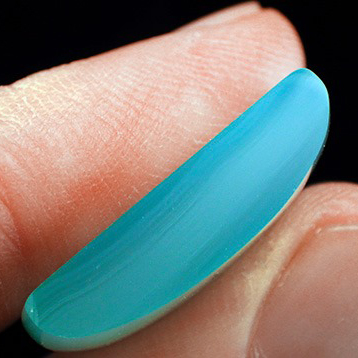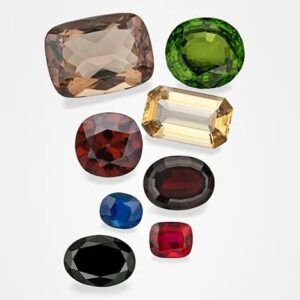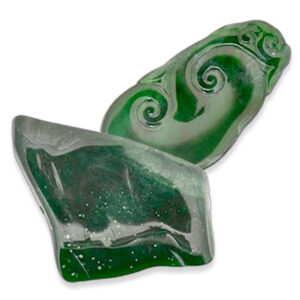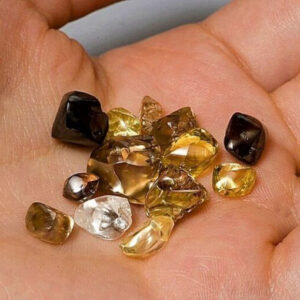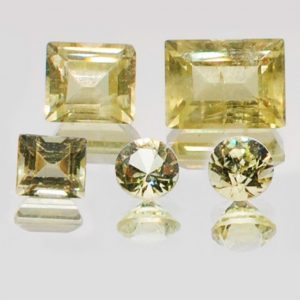GIA Gems & Gemology, Spring 2020, Vol. 56, No. 1
作者:林書弘、李毓和、陳惠芬(海洋大學地球科學所)與方建能(臺灣博物館)
譯者:林書弘 台灣聯合珠寶玉石鑑定中心所長 / 實用寶石學作者 / GIA G. G.
矽孔雀石藍玉髓又稱為寶石二氧化矽(歐美)或藍玉髓(臺灣)是臺灣市場上最有價值的玉髓類別。
藍玉髓美麗的顏色是起因於矽孔雀石的微包裹體,其礦物成分可藉由拉曼光譜3619cm-1振動峰確認之。該振動峰係由於矽孔雀石中的羥基(OH),也因此其藍色基本上歸因於包裹體矽孔雀石之結構中的二價銅離子。在過去幾年中,有大量染色玉髓仿品出現在台灣市場。銅鹽染色藍玉髓的與天然矽孔雀石藍玉髓之顏色皆來自二價銅離子。

最近,有一包玉髓樣品送至台灣聯合珠寶玉石鑑定中心檢驗。這些寶石送驗時宣稱為天然藍玉髓,經拉曼光譜檢驗後確認為玉髓,然而並沒有矽孔雀石的特徵峰(圖1)。

經物主之同意,本所切開其中一個蛋面並拋光其橫切面,顯示出由外向內變淡且平行輪廓的色帶(圖2)。
該樣本經X光螢光光譜儀(EDXRF)檢驗且做銅濃度分佈圖,確認該玉髓之銅元素分佈及中於表層且向中心遞減,這是該玉髓經銅鹽染色的強力證據(圖3)。

進一步以EDXRF分析了20顆銅鹽染色玉髓並比較了20顆天然藍玉髓的分析結果,發現銅鹽染色藍玉髓的矽銅比Si/Cu遠高於天然藍玉髓(分別為400-600與4-50),即所測試的染色玉髓中的銅濃度相對較天然者為低。
有許多種不同類型的染劑應用於玉髓染色,雖然如上所述的一系列測試可以綜合性比較本研究所分析的染色玉髓與天然玉髓,仍需要更多的驗證確認這些方法是否見用於其他染色玉髓。
英文原文請參考 GIA寶石學期刊(GIA Gems & Gemology, Spring 2020, Vol. 56, No. 1)https://www.gia.edu/gems-gemology/spring-2020-gemnews-dyed-chalcedony-imitation-of-chrysocolla-in-chalcedony
Chrysocolla-in-chalcedony, also known as gem silica or blue chalcedony in Taiwan, is the most valuable chalcedony variety on the Taiwanese market. The beautiful greenish blue color is derived from micro-inclusions of chrysocolla, which can be identified by observation of a peak at 3619 cm–1 in the Raman spectrum. This peak can be assigned to OH groups in chrysocolla. Therefore, the color origin for this material is fundamentally rooted in the presence of Cu2+ ions in the structure of the chrysocolla inclusions. In the past few years, a large number of dyed chalcedony imitations have appeared in Taiwan’s market. The blue color of chalcedony dyed by copper salts, and that of natural specimens containing chrysocolla, is caused by Cu2+ ions.
Recently, a parcel of loose chalcedonies was sent to the Taiwan Union Lab of Gem Research (TULAB) for identification. These stones were submitted as natural blue chalcedony, but Raman spectroscopy later confirmed them as chalcedony without the characteristic peaks of chrysocolla (figure 61).
With the owner’s consent, we cut one cabochon and polished the cross section displaying a blue mantle zoning from surface to center parallel to its profile (figure 2). The sample was analyzed with EDXRF, and concentration mapping on the cross section confirmed that copper was concentrated on the surface and decreased toward the interior, which is strong evidence for dyeing with copper salts (figure 3).
Twenty pieces of chalcedony dyed with copper salts were further analyzed with EDXRF and compared to results from twenty pieces of natural blue chalcedony. EDXRF results indicated that the Si/Cu ratio of chalcedony dyed with copper salts was much higher than that of natural blue chalcedony (400–600 and 4–50, respectively). The content of Cu was relatively low in dyed chalcedonies tested.
There are many types of dye used for the color enhancement of chalcedony. Although a series of tests like those used above provide a comprehensive comparison between natural blue chalcedony and the dyed chalcedony analyzed in this research, it requires further verification whether these methods can be applied to other dyed chalcedonies.

原文網址 矽孔雀石藍玉髓的染色玉髓仿品(GIA Gems & Gemology, Spring 2020, Vol. 56, No. 1)
感謝 Tulab台灣聯合珠寶玉石鑑定中心-林書弘老師 文章授權
新品種鉻致色藍綠色玉髓-海水藍綠玉髓
剛果民主共和國的矽孔雀石玉髓
女皇綠玉髓 IMPERIAL CHRYSOPRASE

